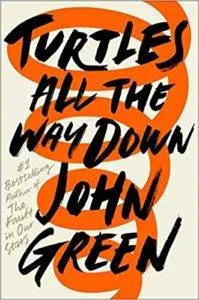
When John Green Starts to Feel Like Your Friend

It’s a spectacular book, but something about it feels different from John’s previous novels. Something more than just his natural development as a writer. More even than how deeply personal this book seems to John’s own experience with obsessive compulsive disorder. I think the difference I feel in TATWD has very little to do with the actual text. I think it’s mainly a difference in me, resulting from my own increased exposure to the author.
At some point between the publications of The Fault in Our Stars and TATWD I became a nerdfighter—a devotee of the YouTube videos and podcast that John Green creates with his brother Hank. Through VlogBrothers and Dear Hank and John, the Green brothers invite viewers and listeners into their friendship in such a way that you don’t feel like an observer; you feel like a participant. This means that without ever meeting John or Hank in person, I have started to feel like I know them.
This familiarity and one-sided friendship I feel with John (or at least with John’s public persona) changes my experience with his books. As I read TATWD, I keep getting very clear flashes of John Green, the person, instead of Aza Holmes, the character. It’s not that John ever slips out of Aza’s voice (he’s scary good at writing from the teenage female perspective, by the way). It’s just that Aza’s voice and John’s voice overlap in my head. Certain passages feel so fundamentally Aza and so fundamentally John at the same time, quotes like: “I wanted to tell her that I was getting better, because that was supposed to be the narrative of illness: It was a hurdle you jumped over, or a battle you won. Illness is a story told in the past tense.”
That’s why TATWD feels so different to me: I “know” John now, so I can’t help but feel him in the text. I think this phenomenon is natural byproduct of loving literature in the digital age. We get easier access to our favorite authors by following their social media, YouTube channels, and podcasts. It inevitably changes the way we read their work. It breaks down that invisible barrier between author and story. What if I, like a lot of kids nowadays, had read the Harry Potter books after JK Rowling became a Twitter personality? How much more would I have felt her authorial presence throughout the books, especially in Harry’s gloriously sassy moments? And what about when Hank Green’s debut novel, An Absolutely Remarkable Thing, comes out. Will I even have a chance to differentiate his narrative voice from his real-life-person voice?
And does it matter?
I don’t really know, but when I start to hear real-life John’s voice in TATWD, it does two things to me at once—simultaneously making the story feel less and more real. On the one hand, it becomes harder to suspend disbelief, because when I become conscious of the story’s author I also become conscious that the story has been authored. But in a book like this, which is so deeply rooted in the author’s own experience with mental illness, it can actually make the conflict feel more real. The thought spirals described in the book aren’t solely an Aza problem. They’re a John problem. They’re a people problem. They exist outside of fiction. It makes me that much more compassionate for Aza and that much more invested in her story.
So when I say that TATWD feels different because of my delusional friendship with John, I do not mean that it feels better or worse, just that it feels closer to me.










